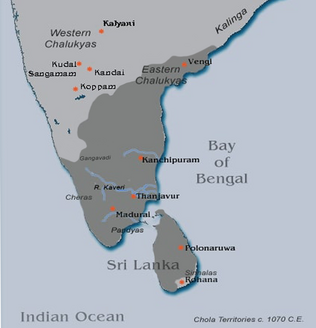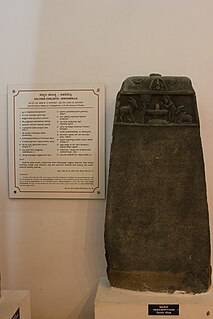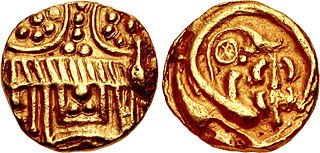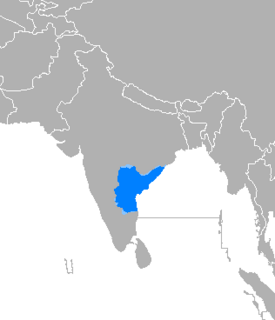
Chakravarti Kulottunga Choladeva was an 11th-century monarch of the Chola Empire of South India. He was one of the sovereigns who bore the title "Kulottunga", literally meaning "the exalter of his race" in Tamil. He did not belong to the main line of Cholas but was rather a prince of the Eastern Chalukya dynasty. His mother was a Chola princess and the daughter of emperor Rajendra Chola I. His father was king Rajaraja Narendra of the Eastern Chalukya dynasty who was the nephew of Rajendra Chola I and maternal grandson of Rajaraja Chola I. According to historian Sailendra Nath Sen, his accession marked the beginning of a new era and ushered in a period of internal peace and benevolent administration.

Kōpparakēsarivarman Rājādhiraja Chōla I was an 11th-century emperor of the Indian Chola empire and the successor of his father, Rajendra Chola I. During his long reign, he helped his father conquer many territories and maintained the Chola authority over most of Lanka, Vengi, Kalinga, etc. and the relations with overseas domains despite a series of revolts in the territory. Rajadhiraja Chola’s record shows that he was a born fighter who was very capable of maintaining a vast and expansive empire with territories even outside the shores of India. He was a great warrior who always led from the front. His life is a testimony to a king who fought his own wars standing shoulder to shoulder with his men on front lines. He earned the title Jayamkonda Cholan after numerous victories. Towards the end of his reign he sacked the Western Chalukyan capital Kalyanapuram and assumed the title Kalyanapuramgonda Chola and performed a virabhisheka under the name Vijaya Rajendra Cholan. One of his predecessors, Rajaraja Chola I also assumed the title Jayangonda Chola towards the end of his reign.

Vikramaditya VI became the Western Chalukya King after deposing his elder brother Someshvara II, a political move he made by gaining the support of Chalukya vassals during the Chola invasion of Chalukya territory. Vikramaditya's reign is marked with the abolishment of the Saka era and the start of the Chalukya-Vikrama era. He was the greatest of the Western Chalukya kings and had the longest reign in the dynasty. He earned the title Permadideva and Tribhuvanamalla. He had several queens who ably assisted him in administration. One of his queens, Chandala Devi, a princess from the Shilahara ruling family of Karad was called Abhinava Saraswati for her skills as an artist. Queen Kethala Devi administered the Siruguppa region and Savala Devi was in charge of an Agrahara in Naregal. According to the historian Kamath, Vikramaditya VI was a "great king who ruled over South India" and he finds a "pride of place in Karnataka history". More inscriptions in Kannada are attributed to Vikramaditya VI than any other king prior to the Vijayanagara era.

Virarajendra Chola is considered to be one of the most underrated Chola kings, mainly because a major part of his life was spent as a subordinate of his two elder brothers Rajadhiraja Chola I and Rajendra Chola II, who along with Virarajendra Chola himself were the illustrious sons of their Chakravarti(Emperor) father, Rajendra Chola I. While certainly it was not a practice among the Chola kings to nominate the eldest son, but the most capable as the heir to the throne. During his early reign he granted the maintenance of a school to study the Vedas, Sastras and Grammar and a hostel was provided for the students. A hospital named Virasolan was also provided by him for the sick people. The famous grammatical work in Tamil, Virasoliyam was written by Buddhamitra during his reign.
Athirajendra Chola reigned for a very short period of few months as the Chola king succeeding his father Virarajendra Chola. His reign was marked by civil unrest, possibly religious in nature, in which he was killed. The Chalukya Chola prince Rajiga succeeded him as Kulothunga Chola I.

The Later Chola dynasty ruled the Chola Empire from 1070 C.E. until the demise of the empire in 1279 C. E. This dynasty was the product of decades of alliances based on marriages between the Cholas and the Eastern Chalukyas based in Vengi and produced some of the greatest Chola emperors such as Kulothunga Chola I. Even though the later Cholas are often referred to as Chalukya Cholas, there were two breaks in the line. Kulothunga Chola II and Rajadhiraja Chola II did not belong to the Chalukya Chola line. Kulottunga II was a grandson of Vikrama Chola and Rajadhiraja Chola II was not the son of Rajaraja Chola II.
The Telugu Chodas or Telugu Cholas ruled parts of present-day Andhra Pradesh between the sixth and the thirteenth century.

Tailapa II, also known as Taila II and by his title Ahavamalla, was the founder of the Western Chalukya dynasty in southern India. Tailapa claimed descent from the earlier Chalukyas of Vatapi, and initially ruled as a Rashtrakuta vassal from the Tardavadi-1000 province in the modern Bijapur district of Karnataka. When the Rashtrakuta power declined following an invasion by the Paramara king Siyaka, Tailapa overthrew the Rashtrakuta king Karka II, and established a new dynasty.

Rajaraja Chola III succeeded Kulothunga Chola III on the Chola throne in July 1216 CE. Rajaraja came to the throne of a kingdom much reduced in size as well as influence. With the rise of the Pandya power in the south, the Cholas had lost most of their control of the territories south of the river Kaveri and their hold on the Vengi territories in the north was slipping with the emergence of the Hoysala power.

Someshvara I was a notable king of the Western Chalukyas. Also known as "Ahavamalla" or "Trilokamalla", Someshvara succeeded his father Jayasimha II to the throne.

The Western Chalukya Empire ruled most of the western Deccan, South India, between the 10th and 12th centuries. This Kannadiga dynasty is sometimes called the Kalyani Chalukya after its regal capital at Kalyani, today's Basavakalyan in the modern Bidar District of Karnataka state, and alternatively the Later Chalukya from its theoretical relationship to the 6th-century Chalukya dynasty of Badami. The dynasty is called Western Chalukyas to differentiate from the contemporaneous Eastern Chalukyas of Vengi, a separate dynasty. Prior to the rise of these Chalukyas, the Rashtrakuta empire of Manyakheta controlled most of Deccan and Central India for over two centuries. In 973, seeing confusion in the Rashtrakuta empire after a successful invasion of their capital by the ruler of the Paramara dynasty of Malwa, Tailapa II, a feudatory of the Rashtrakuta Dynasty ruling from Bijapur region defeated his overlords and made Manyakheta his capital. The dynasty quickly rose to power and grew into an empire under Someshvara I who moved the capital to Kalyani.
Rajendra Choda I was a Telugu king and the second of Velanati Chodas who ruled from 1108 to 1132 AD.
Gonka II was a Telugu king and the third of Velanati Chodas who ruled from 1132 to 1161.
Sudi, is a panchayat town in the Gadag District of Karnataka, India. It is about 30 km from Badami, 12 km from Gajendragad and 3 km from Itagi Bhimambika temple. In the past it was an important town of the Kalyani Chalukyas during 1000 AD. It is notable for rare stone carved monuments like Twin towered temple, Mallikarjuna temple and nagakunda , and few other structural temples. For long time these structures were abandoned, but recently they caught the eye of the Indian Archaeological Department.
Bidar is a historic place located in the north-eastern part of the South Indian state of Karnataka. Bidar enjoys a picturesque situation, having been situated and built on the brink of a plateau, and thus commanding lovely views of the lowlands (talghat) towards the north and the east. Its latitude is 17°55'N., its longitude 77°32' E., and the height above the sea-level 2,330 feet (710 m). The climate is bracing and the temperature in the hottest season does not usually rise above 105 °F (41 °C). The Bidar plateau is an irregular oblong, 22 miles (35 km) in length and 12 miles (19 km) in extreme breadth.
The Kalachuris of Tripuri, also known the Kalachuris of Chedi, ruled parts of central India during 7th to 13th centuries. Their core territory included the historical Chedi region, and their capital was located at Tripuri.

The 11th century Paramara king Bhoja ruled from his capital at Dhara. The period of his reign is dated approximately 1010 CE to 1055 CE, although some historians believe that he ascended the throne before 1010 CE. Bhoja inherited a kingdom centered around the Malwa region, and made several attempts to expand it varying results. He managed to annex territories as far as northern parts of Konkan, but these territorial gains were short-lived. He fought wars against several of his neighbours, including the Chaulukyas of Gujarat, the Chalukyas of Lata, the Chalukyas of Kalyani, the Chandelas of Jejakabhukti, the Kachchhapaghatas of Gwalior, the Chahamanas of Shakambhari, the Chahamanas of Naddula, and the Kalachuris of Tripuri.
Jayasimha was the first ruler of the Chalukya dynasty of Vatapi in present-day India. He ruled the area around modern Bijapur in the early 6th century, and was the grandfather of the dynasty's first sovereign ruler, Pulakeshin I.










